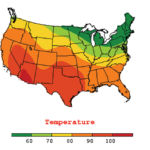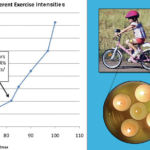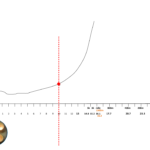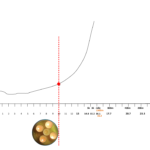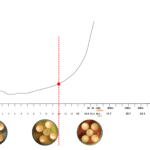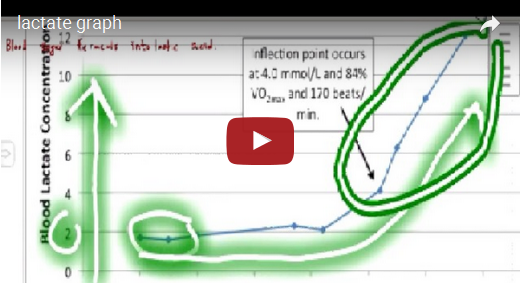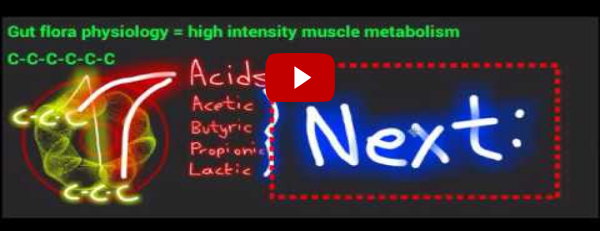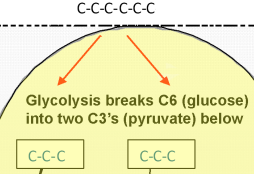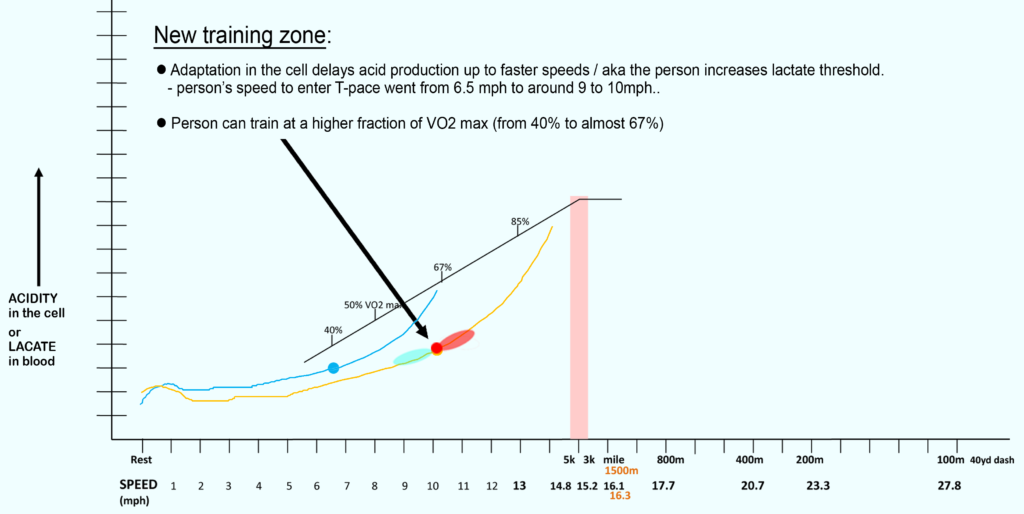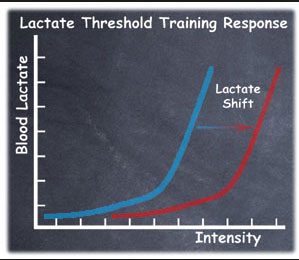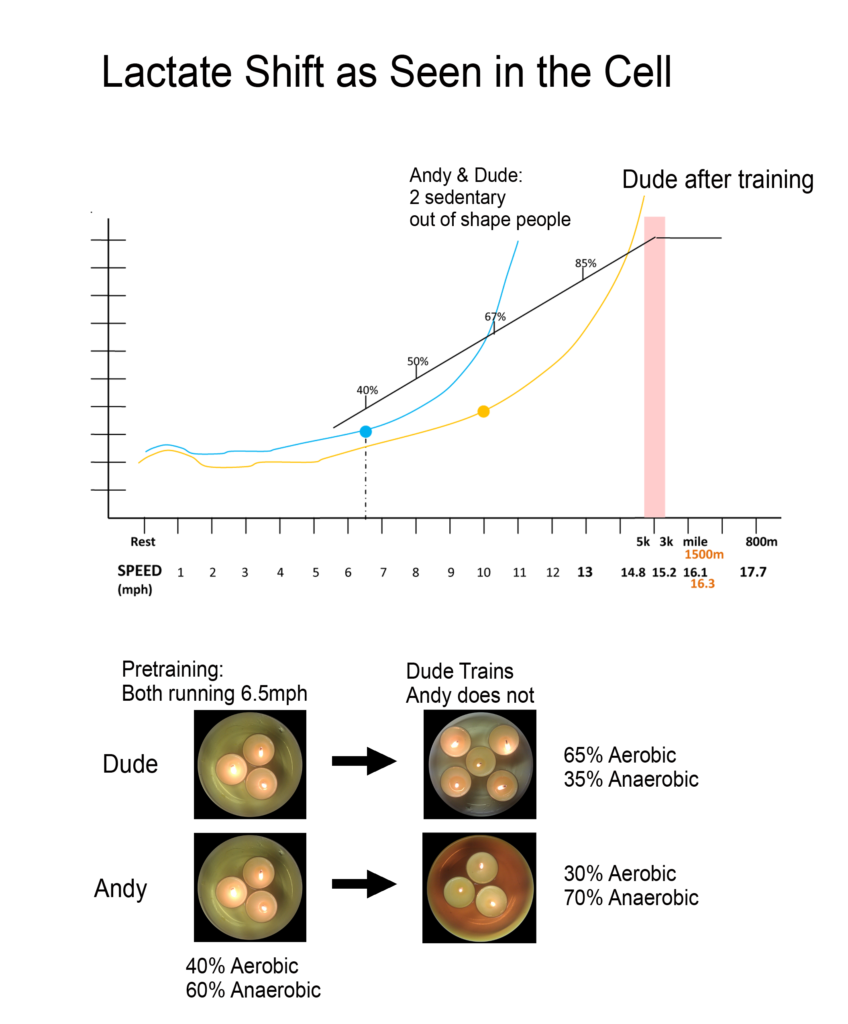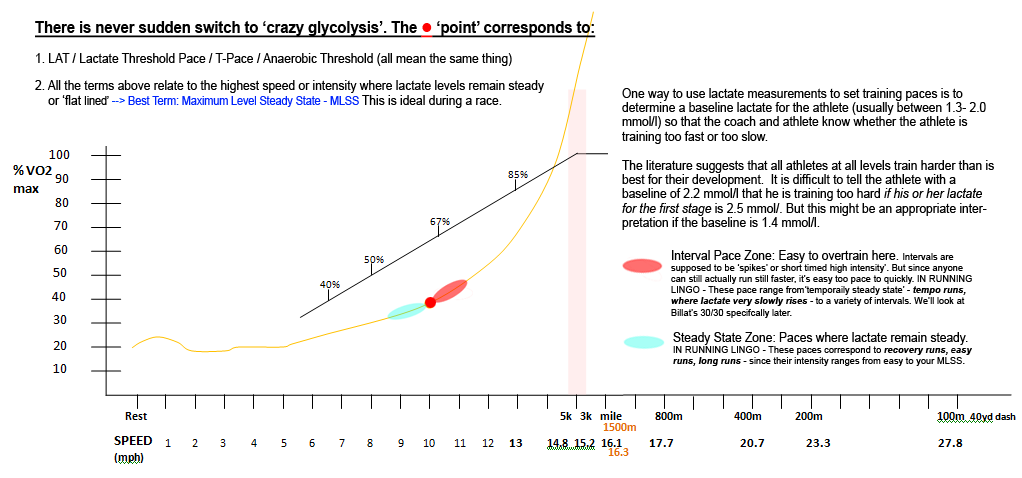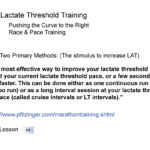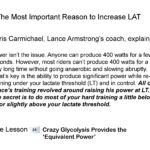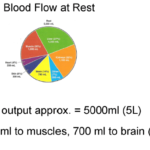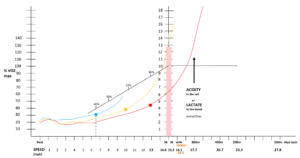Week 4. Glycolysis Visualized
Can you sprint without breathing?
Yes you can, but why?
The answer is, “Because it’s powered anaerobically.”
That is, your muscle cells produce the power without oxygen.
This process or type of metabolism is called by these names:
- Glycolysis
- Sugar fermentation
- Anaerobic metabolism
- Non-oxidative metabolism
In the previous readings and lectures I made it clear that oxygen produced power within muscle cells cannot produce high intensity power – and that in order to produce more power past VO2 max – something called lactate is produced at an exponential rate as speed and power increase, as shown again below in the VO2 graph with the red lactate curve.
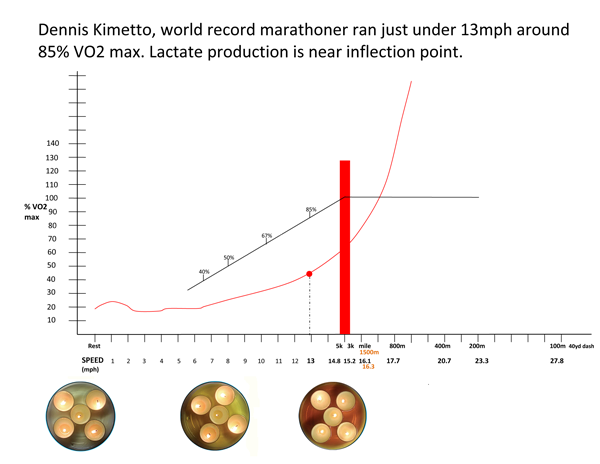
Accelerating past 15 mph, extreme anaerobic glycolysis powers the body (as lactate increases exponentially) toward sprinting speeds reached by track athletes – up to Usain Bolt’s world record 27.8mph
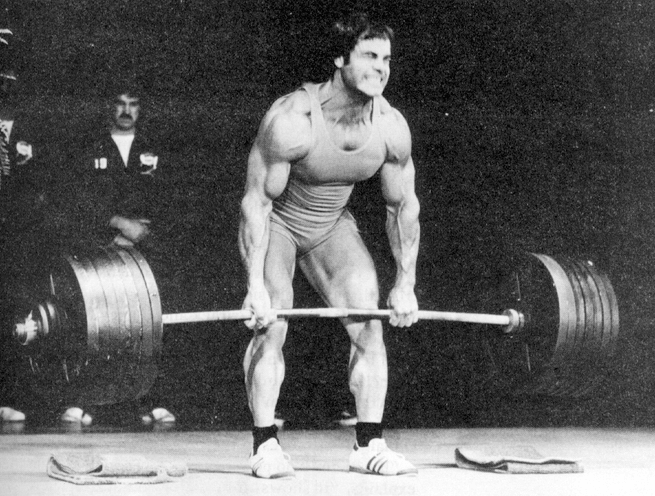
By definition all anaerobic exercise (e.g. sprinting, weight lifting) does not require oxygen to produce the movement.
Now we look within the cell itself transforming glucose into a substance called lactate – using cell models to see how it works in the picture gallery below..
IMPORTANT! Tap or click the image to dismiss or recover the captions.
Next, let’s see how the rate of glycolysis in a cell corresponds to real world walking and running – in MPH from rest to 27.8mph.
Matching Glycolysis (and Lactate Production) to Real World Walking and Sprinting in MPH.
The lactate production in the cells and the graphs below correspond to speeds ran by humans in mph – from rest up to the world’s fastest sprint speed ever recorded – 27.8 mph by Usain Bolt.
The bold face type lists the world record speeds ran by humans in all races from the 5K to the 100m dash.
The takeaway messages:
The intensity of glycolysis in a cell at any moment ALWAYS corresponds to a ‘like intensity’ you perform at in the physical world.
Glucose converts to lactate in cells always in some amount.
The crude screencast video below shows everything just explained.
Cell Anatomy 101: Mitochondria are not The True Powerhouse of the Cell
Most writers call mitochondria the “powerhouse of a cell” – which is incorrect in terms of applied physics of exercise or the concrete reality of producing top speed and power. Mitochondria – represented by the candles where aerobic metabolism occurs – do not produce high intensity power.
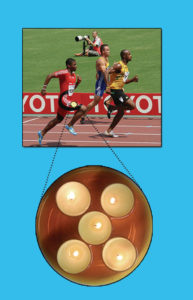
Aerobic metabolism cannot produce sprinting type power, but instead produces long-term sustainable movement, maxingout at the elite level around 13mph in the world record marathoner, Dennis Kimetto, as graphed below:
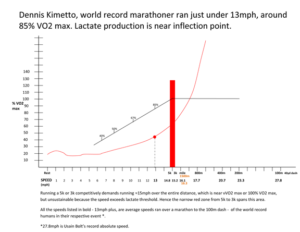
Dennis Kimetto, world record marathoner ran just under 13mph, around 85% VO2 max. Lactate production is near inflection point. Running world record times for the 5k or 3k requires running ≈15mph over the entire distance, which is near vVO2 max or 100% VO2 max, but unsustainable because the speed exceeds lactate threshold. Hence the narrow red zone from 5k to 3k spans this red area.
Cell Anatomy 101: The Cytosol is the Physical Powerhouse of the Cell
The yellow food colored water represents the anaerobic section of a cell called the cytosol.
Glucose transforms or ferments into lactate in the cytosol.

Glucose is the only fuel substrate used in the cytosol.
Fat cannot be used in the cytosol, which indicates fat cannot ferment; fat only burns or is used ONLY aerobically in the mitochondria.
The cytosol is where it’s at for producing very high intensity ‘glycolytic’ power.
Putting it All Together
“Rate of lactate production” means the rate of glycolysis in a cell.
You do not feel lactate or acid produced at rest or during low to moderate intensity exercise – but it is happening in your cells as you read this. Lactate production results from being alive while cells use blood sugar.
Very high rates of glycolysis indicate:
- High rate of glycogen depletion. (detailed next lecture)
- Glucose (blood sugar) is ‘sucked’ out of blood into muscle cells, which can make a person momentarily dizzy or light headed during intense exercise.
- The liver speeds up releasing glucose into the blood stream to keep blood sugar steady.*
- A very high carb intake is necessary to replete muscle glycogen. (detailed next lecture)
*Sipping on sugar drinks do the same as the liver does – and may help delay running out of fuel in long distance events.
Why is Lactate Often Called Lactic Acid?
High exercise intensities actually do make cells acidic – but the acidity is a result of hydrogen ions (H+) produced in a cell during high intensity exercise.
Adding H+ ions to any watery thing generally increases its acidity, and since cells are made mostly from water, high intensity exercise increases a cells acidity.
- Both acidity (and lactate) skyrocket during very high intensity exercise, which shuts a muscle down and in turn, you are forced to slow down.
At any rate, many people refer to the simultaneous rise in lactate and H+ as if its the same thing.
However…
Lactate is actually a ‘buffer’ against the acidic condition in a cell, meaning:
Lactate binds with H+ ions and transports H+ out of the muscle cell into the blood.
- The blood never becomes acidic by a buildup of ‘lactic acid’, because when H+ is buffered by lactate, its acidifying power is canceled out.
Most people just call this stuff made during high intensity exercise lactic acid. But it is really two things put together, lactate and H+.
At any rate, the exponential increase of lactate (measured in blood) can be considered essentially the same event as the exponential production of H+ ions in muscles cells.
We can’t poke and prod into cells to measure lactate, but we can draw blood to measure the combined form: lactate/H+.
This is why I label the y-axis of the graph: ‘acidity in the cell’ and ‘lactate in the blood’.
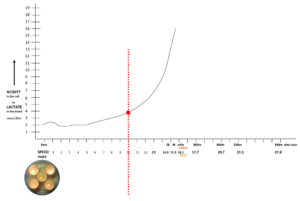
Even at rest, your cells produce a bot of lactate. When starting to walk, you see a bump in acid levels then fall if you continue to move slowly as shown. But as intensity increases, acid levels rise slowly and steadily.
Food and Nutrition in the Cell:
Anaerobic Glycolysis is the Muscle Fermenting Sugar (Glucose)
Glucose is a simple sugar made of 6 carbon atoms. C-C-C-C-C-C (or C6 in shorthand)
Lactate is made when glucose splits (ferments) into two 3-carbon chunk molecules – or two lactates – as shown simply in the graphic, but animated within a cell in the video below.
Fermentation means ‘splitting’ complex carbohydrates or sugars into smaller carbon chunks.
- Splitting carbohydrates and sugars in grapes, grains, potatoes, honey and many more foods into smaller carbon chunks is technically called fermentation. Alcohol is only one product among several others produced by fermenting carbohydrates.
- Glycolysis is just a muscle cell’s form of fermenting glucose (into lactate).
Common “ferments of sugars” (ferments are products of fermenting carbohydrates) include alcohol, acetic acid (in kombucha and vinegar), lactate in muscle cells, butyric acid in butter, and the acid that gives Swiss cheese its distinct smell… propionic acid.
Muscles can ferment only one sugar – glucose – which is made of 6 carbon atoms.
C-C-C-C-C-C (for simplicity)
The ‘split’ of glucose or first step of glycolysis is not actually into lactate, but rather into a 3-carbon chunk called pyruvate*.
- *Think a ‘pyromanic’ makes a fire to associate this idea: if pyruvate is used aerobically, then it will combine with oxygen in the mitochondria during aerobic metabolism. When this happens, CO2 is made.
- When pyruvate is used anaerobically it will ferment into lactate.
Thus, glucose is actually a hybrid fuel.
When pyruvate is used anaerobically this still means glucose is fermented into lactate. I skipped the pyruvate step because that would have presented another road leading to examination of aerobic metabolism, which is not covered in depth in this lecture.
At any rate, glucose first splits into pyruvate – and if you are performing very high intensity exercise – it is correct to think glucose ferments into lactate at an exponential rate, which will lead to muscle failure when lifting weights or force you to slow down when running.
The difference between anaerobic and aerobic metabolism is a matter of splitting a set carbon atoms versus combining carbon atoms with some other atom.
First consider anaerobic metabolism in terms of splitting carbons.
At any level of anaerobic metabolism, glucose splits in half to produce energy, sort of like splitting an atom (in a fission bomb) releases energy. After all said and done fermenting glucose, 6 carbon atoms have split into two sets of 3 carbons, but 6 carbon atoms still remain.
Aerobic metabolism combines carbon with oxygen (O2).
Aerobic metabolism is a form of combustion. Carbon (Fuel) + O2 –> CO2 + H2O + Heat
For practical purposes, imagine high intensity anaerobic exercise splits glucose in half at an exponential rate akin to splitting an atom in a fission bomb. In each case, tremendous energy is released.
Unlike an atom bomb, a hydrogen bomb or a fusion bomb fuses atoms together to make something new – akin to how the carbon atoms from glucose and pyruvate will eventually fuse with O2 to make CO2.
In a hydrogen bomb two hydrogen atoms fuse together to make helium (just as our sun does), which produces way more energy and destruction than a fission bomb.
Two fission (atom) bombs ended World War II.
How training enables people to run at a higher percentage of their VO2 max.
An ‘out of shape’ person (blue line in graph) shifts into high rates of anaerobic glycolysis at lower intensities compared to a fit or trained person (gold line). Trained humans have higher lactate thresholds.
Thus, a trained person occurs at a higher fraction of VO2 max compared to a detrained person because they have a higher lactate threshold – shown below.
The key to ‘shifting’ a lactate curve to the right is to train at, near, or slightly above lactate threshold – which is when you are not using enough oxygen to power your cells to prevent using too great of a proportion of anaerobic power to supply the power.
- In other words, this also means you are slightly ‘starving the cell’ of oxygen, which forces the cell to adapt itself by adding more mitochondria and enables it to use more oxygen the ‘next time out’.
When you train and adapt this way, your lactate production will spike exponentially ‘later’ at faster speeds – shown by shifting the curve to the right.
Having a high VO2 max doesn’t necessarily allow a person to sustain running a competitive pace if they are detrained, have a lowered lactate threshold, and can sustain running only at lowered percentage of their VO2 max.
This explains why VO2 max is not a predictor of race performance – but lactate threshold is.
Additionally, people who train gain the ability to run near or at lactate threshold – or put up with the pain longer. It requires sustained mental and physical effort to perform near lactate threshold.
Compare the ability to sustain performing at threshold:
- Out of shape people: 30-45 minutes
- Recreational athlete: 60 minutes
- Pro-elite athletes: 90 minutes
It is uncomfortable to sustain paces near lactate threshold. This partially explains why some people never work hard enough to improve fitness or whine about ‘hard work’. This is pretty much the only time ‘no pain no gain’ should be thought as a positive.
So when an out of shape person increases their fitness this means they increased lactate threshold – shown by pushing the curve to the right. This is called the lactate shift.
After a year of training it is possible that an out of shape person could shift lactate threshold from 6.5 mph to 10mph as shown in the shift from the blue to the gold line below.
Illustrated below: Color coded zones of lactate threshold training and the coaching lingo to go with it.
In a nutshell the key to increasing fitness and/or competitive race paces is to work near, at, or slightly above lactate threshold pace.
Parting Thoughts and Advancing Thoughts
Muscle’s demand for producing power is evident by the 500% increase of blood flow over their resting levels at their maximum VO2 produced power, which maxes out at 15 mph in the world’s fastest runners.
Going forward, do not forget the heart is under great strain performing running competitively. It stretches dramatically as it’s forced to expand – by filling up with up to 2x the amount of blood in order to sustain high aerobic speeds – maximized over time in the 1/2 marathon to marathon distances and maximized at the peak of the aerobic-max-stress point in the 3k and 5k races.
Additionally to the stress/strain on heart muscle tissue and arteries – cellular level fatigue leads to permanently energetic depletion of cells of the heart – resulting in mitochondrial damage, swollen/inflamed cells – beyond the damage mentioned by O’Keefe et al. in Run For Your Life. (Examined by other researchers)
I am purposely conditioning you to come to realize excessive endurance exercise can seriously damage your heart, arteries, and blood – besides your knees and feet.
Comparing Other People to the World Record Marathon Runner, Dennis Kimetto
Red line/dot: Dennis Kimetto, World Champion Marathoner runs 26.4 miles averaging just under 13mph. The red dot shows where Dennis Kimetto’s ‘race pace’ acid levels are before rising exponentially – just under 13mph at 85% VO2 max.
Blue line/dot: An ‘out of shape’ person’s threshold pace is at 6.5mph or 40%VO2 max – with acid levels shifting exponentially ‘sooner’ at lower speeds.
Gold line/dot: A fit person reaches race pace or lactate threshold occurs at 10mph or 65% VO2 max.
Questions & Thoughts for Students
Which meat/muscle on a chicken – dark or white – is made especially for anaerobic power?
If you cut blood flow off to your cells, say by applying a tourniquet or interrupting blood flow to your leg, how do the cells produce energy?
Early or primitive life forms such as bacteria transform energy in a more rudimentary way (anaerobically via fermentation) compared to later developed, complex lifeforms. Thus, the cytosol of a human is the ‘bacterial’ or primitive section of the cell that ferments glucose into lactate.
Glycolysis = fermentation of sugar within the ‘bacterial’ section of the cell.
The mitochondria is considered the ‘advanced’ section of the cell because it’s found in later developed life forms from dinosaurs to mammals which use oxygen, beyond primitive lifeforms’ limited way to produce energy.

